Intel SSD 520 Review: Cherryville Brings Reliability to SandForce
by Anand Lal Shimpi on February 6, 2012 11:00 AM ESTAnandTech Storage Bench 2011
Last year we introduced our AnandTech Storage Bench, a suite of benchmarks that took traces of real OS/application usage and played them back in a repeatable manner. I assembled the traces myself out of frustration with the majority of what we have today in terms of SSD benchmarks.
Although the AnandTech Storage Bench tests did a good job of characterizing SSD performance, they weren't stressful enough. All of the tests performed less than 10GB of reads/writes and typically involved only 4GB of writes specifically. That's not even enough exceed the spare area on most SSDs. Most canned SSD benchmarks don't even come close to writing a single gigabyte of data, but that doesn't mean that simply writing 4GB is acceptable.
Originally I kept the benchmarks short enough that they wouldn't be a burden to run (~30 minutes) but long enough that they were representative of what a power user might do with their system.
Not too long ago I tweeted that I had created what I referred to as the Mother of All SSD Benchmarks (MOASB). Rather than only writing 4GB of data to the drive, this benchmark writes 106.32GB. It's the load you'd put on a drive after nearly two weeks of constant usage. And it takes a *long* time to run.
1) The MOASB, officially called AnandTech Storage Bench 2011 - Heavy Workload, mainly focuses on the times when your I/O activity is the highest. There is a lot of downloading and application installing that happens during the course of this test. My thinking was that it's during application installs, file copies, downloading and multitasking with all of this that you can really notice performance differences between drives.
2) I tried to cover as many bases as possible with the software I incorporated into this test. There's a lot of photo editing in Photoshop, HTML editing in Dreamweaver, web browsing, game playing/level loading (Starcraft II & WoW are both a part of the test) as well as general use stuff (application installing, virus scanning). I included a large amount of email downloading, document creation and editing as well. To top it all off I even use Visual Studio 2008 to build Chromium during the test.
The test has 2,168,893 read operations and 1,783,447 write operations. The IO breakdown is as follows:
| AnandTech Storage Bench 2011 - Heavy Workload IO Breakdown | ||||
| IO Size | % of Total | |||
| 4KB | 28% | |||
| 16KB | 10% | |||
| 32KB | 10% | |||
| 64KB | 4% | |||
Only 42% of all operations are sequential, the rest range from pseudo to fully random (with most falling in the pseudo-random category). Average queue depth is 4.625 IOs, with 59% of operations taking place in an IO queue of 1.
Many of you have asked for a better way to really characterize performance. Simply looking at IOPS doesn't really say much. As a result I'm going to be presenting Storage Bench 2011 data in a slightly different way. We'll have performance represented as Average MB/s, with higher numbers being better. At the same time I'll be reporting how long the SSD was busy while running this test. These disk busy graphs will show you exactly how much time was shaved off by using a faster drive vs. a slower one during the course of this test. Finally, I will also break out performance into reads, writes and combined. The reason I do this is to help balance out the fact that this test is unusually write intensive, which can often hide the benefits of a drive with good read performance.
There's also a new light workload for 2011. This is a far more reasonable, typical every day use case benchmark. Lots of web browsing, photo editing (but with a greater focus on photo consumption), video playback as well as some application installs and gaming. This test isn't nearly as write intensive as the MOASB but it's still multiple times more write intensive than what we were running last year.
As always I don't believe that these two benchmarks alone are enough to characterize the performance of a drive, but hopefully along with the rest of our tests they will help provide a better idea.
The testbed for Storage Bench 2011 has changed as well. We're now using a Sandy Bridge platform with full 6Gbps support for these tests.
AnandTech Storage Bench 2011 - Heavy Workload
We'll start out by looking at average data rate throughout our new heavy workload test:
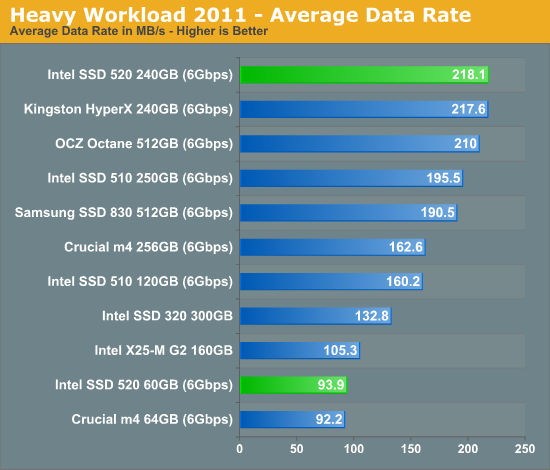
SandForce has always done well in our Heavy Workload test, and the 520 is no different. For heavy multitasking workloads, the 520 is the fastest SSD money can buy. Note that its only hindrance is incompressible write speed, which we do get a hint of in our breakdown of read/write performance below.

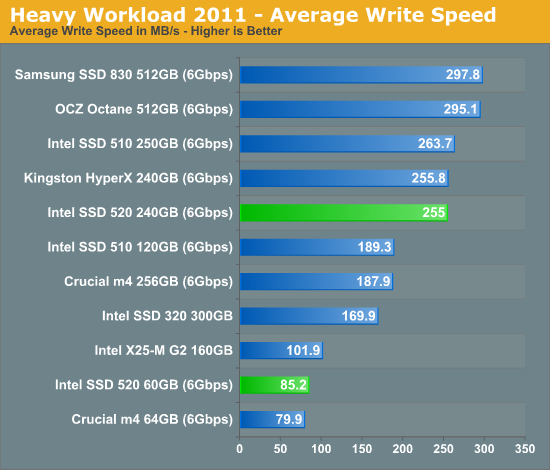
The next three charts just represent the same data, but in a different manner. Instead of looking at average data rate, we're looking at how long the disk was busy for during this entire test. Note that disk busy time excludes any and all idles, this is just how long the SSD was busy doing something:
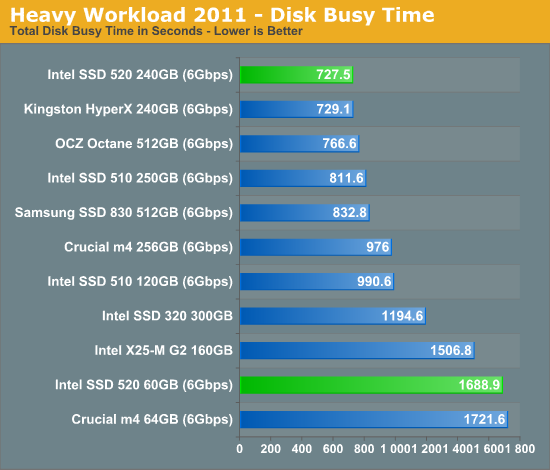
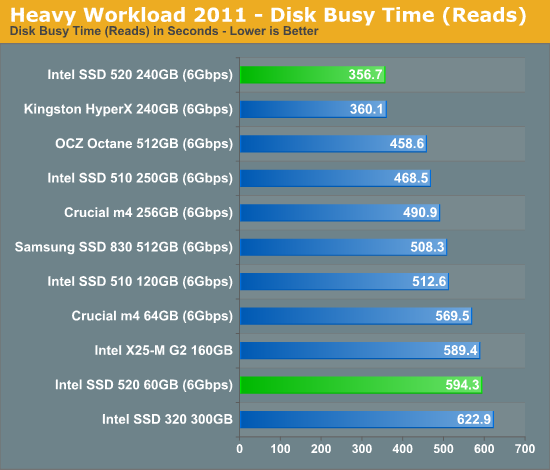
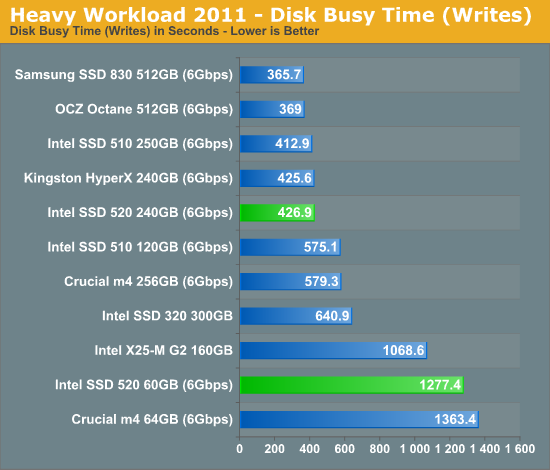










138 Comments
View All Comments
frank1985 - Monday, February 13, 2012 - link
I am a customer of this guy, and I had to return my $240 Corsair Force 2 drive/paperweight *11 days* after purchase (at which point I traded it in for his old OCZ Vertex2 which has been running without issue).Like Iketh, the fact that you can't recover performance with TRIM is a showstopper for me. I'm going to stick with the 320 series drives - they might be slower, but TRIM does what it's supposed to.
Wolfpup - Monday, July 23, 2012 - link
The TRIM issue worries me too. Sounds like it's even worse than on Micron/Crucial's M4?My 320's been great, though annoyingly the 600GB version is MASSIVELY more than the 480GB 520, or the 512GB M4...possibly because of this issue?
Ratman6161 - Wednesday, February 8, 2012 - link
I have an OCZ drive based on the SF22xx. For the first month it was nothing but trouble. Then with the release of the 2.15 firmware, suddenly all the problems went away like magic. It could simply be that OCZ paid the price for being early adopters and released to the market a product that really should have been a Beta version. Now that it has the firmware that it should have had from the beginning, everything is fine.Intel has waited until the product is more mature so its no surprise they aren't seeing these problems
Wolfpup - Monday, July 23, 2012 - link
Did you read the article? Intel explicitly fixed problems still present in other firmware.ckryan - Tuesday, February 7, 2012 - link
The Samsung 830 is maybe the finest consumer drive released in all of 2011. There is no shame in going Samsung, and in my mind, it's a fine alternative to almost every drive out there.Samsung and Micron probably have to wonder how Intel gets all the press about their NAND being better. As far as I can tell, Samsung's 27nm Toggle in the 830 is pretty damn good. The Micron NAND used in Micron's own drives is fantastic, and of course Intel's top shelf NAND is good too. But only Intel gets the press for having excellent NAND in it's own drives.
I don't think enough emphasis is placed on the NAND. You can't get a clear picture of NAND quality through benchmarking.
krumme - Monday, February 6, 2012 - link
Exit Intel from the controller market. No wrapping in reliability, as rightfully as it is, can change that fact seen from here.Anyway, Intel can earn on the memory, as was probably the plan from day 1. We will see how profitability is here in 5 years time.
tipoo - Monday, February 6, 2012 - link
I still get a kick out of how a relatively tiny startup company makes better performing parts than the chipzilla that is Intel. Good call working with them.Makaveli - Monday, February 6, 2012 - link
What I think you are missing is that Intel doesn't because they don't have to or care to. Intel is a huge company with equally big profit margins to maintain for their shareholders. The SSD market is still a small compared to the other things they dabble in. And yes they produced a controller in the past but I don't think the Money and R&D was worth it for them to continue based on the profits needed to keep them interested. We already know they make a ton of money selling nand as is.So to sum it up they could easily put out a controller that would be superior but just don't care too at the moment.
Kevin G - Monday, February 6, 2012 - link
Intel's plan was to gain control of the entire SSD product: from flash (joint venture with Micron), to the controller and to the firmware. It does appear that their original plan has fallen apart due to delays with their custom controllers which has forced them to use 3rd party controllers.I wouldn't say that Intel has stopped investing into developing their own controllers though. Intel can offer a level of integration that no other vendor can offer: direction integration into an x86 SoC. I strongly suspect that the successor to Haskwell and future Atom SoC will come with a direct ONFI connectivity backed by an internal Intel controller.
At that point in time, I suspect that SSD controllers will become akin to what discrete GPU's are today: a midrange or high end item for consumers.
NitroWare - Wednesday, February 8, 2012 - link
People forget Intel was one of the innovators in bringing MATURE Flash to consumer technologies.Intel Desktop and OEM motherboards have used their surface mount flash chips for PC BIOS since 1996. This setup provided a recovery mode to get out of BIOS corruption. To this day, excluding motherboards with dual BIOS no motherboard has the same robust recovery system as Intel boards do.
If the recovery mechanism fails then there is a more serous failure anyway.
At the time other vendors were still using older DIP socket EEPROM and some still do now , only changing to serial format ROM.
Even for current ASUS Flagship ROG boards, the best failsafe they offer is a socketed BIOS.
Intel offered those Turbo Boost Flash cards several years ago for the 1156 motherboards and laptops which did not take off. They also championed Hybrid HDD for portables.
So I think Intel know what they are doing with solid state, but yes eventually the technology will become commodity